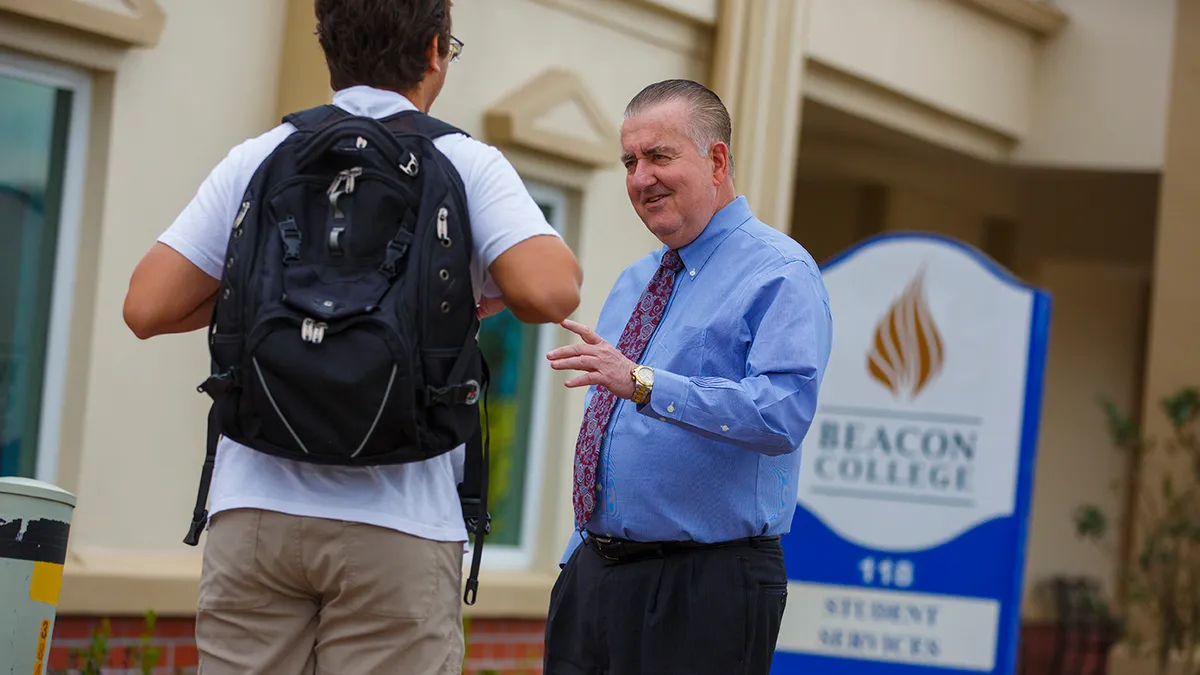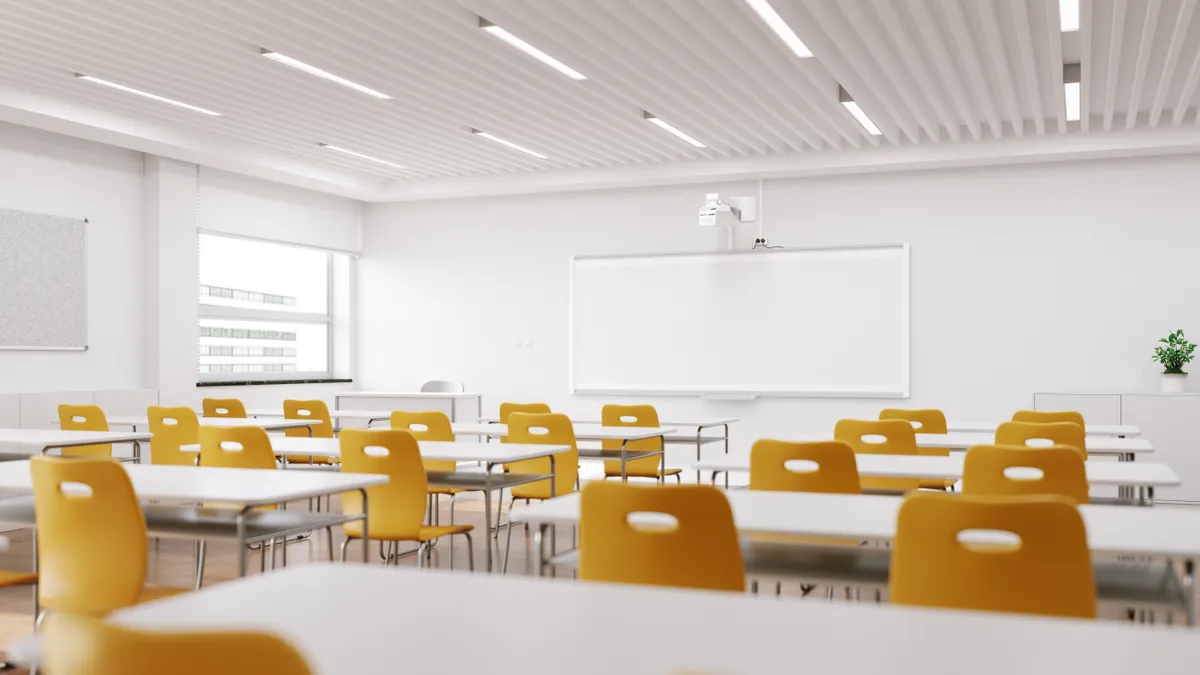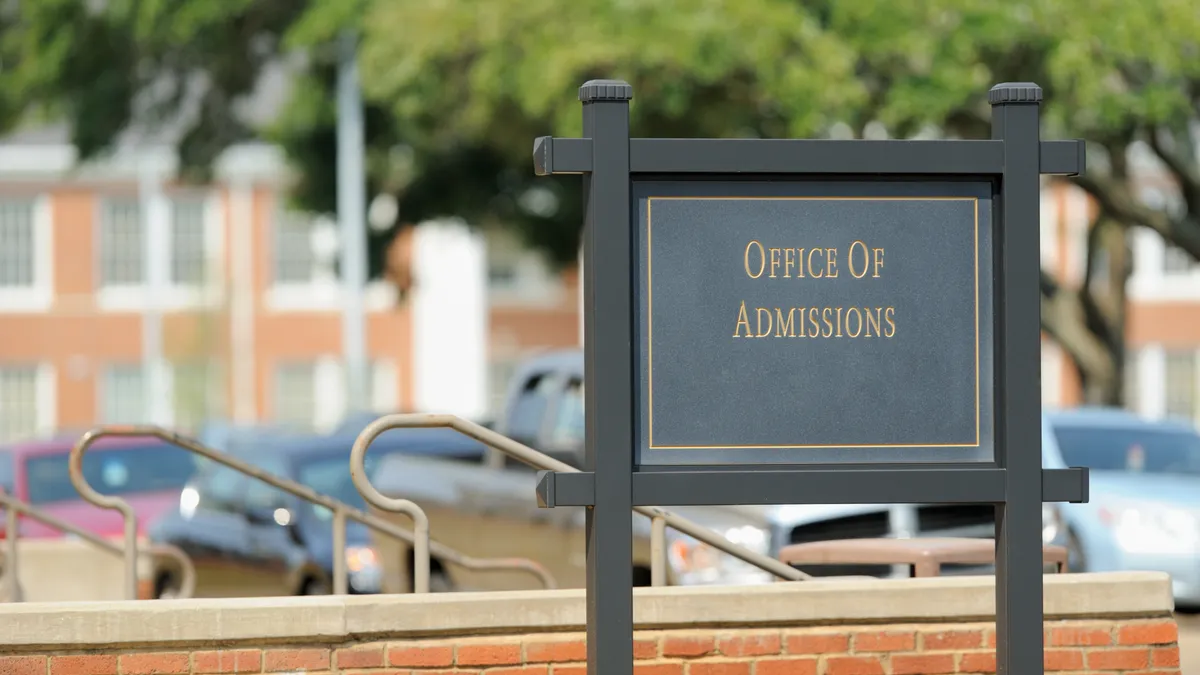Beacon College President George Hagerty wants his students to know that their “island of challenge” does not dictate the heights they can achieve. For Hagerty, who is legally blind himself, the opportunity to work with learning-challenged students as president of the Leesburg, FL institution founded entirely for them has been “a huge gift to me,” he said recently via telephone.
After beginning his career as a postdoctoral fellow at the U.S. Department of Health, Welfare and Education — and then at its successor, the U.S. Department of Education, when it was established by President Jimmy Carter — where he had a heavy hand in implementing special education policies and the predecessor to the Individuals with Disabilities in Education Act. Now, Hagerty has come full-circle as president of an institution founded specifically to help individuals with learning disabilities.
We recently caught up with Hagerty to talk about the unique institution he leads and lessons in working with learning challenged students in any environment.
Note: The following comments have been edited and condensed for clarity.
EDUCATION DIVE: Talk to me about Beacon College — how did the institution get its start?
GEORGE HAGERTY: Beacon College was founded by a group of, I think they were visionary parents who, in 1989, they recognized that students with learning disabilities could successfully achieve an undergraduate education if they had the right model in place.
The model is a traditional undergraduate model — we’re accredited [by the Southern Association of College and Schools Commission on Colleges], so it has to be a traditional undergraduate model — with two additional features. We teach multimodally in the classroom, so it’s not the traditional lecture with overheads. … And we also have a learning specialist model. Every student who enrolls here gets assigned a learning specialist. … They must meet with them at least one hour a week. Some of the students ... by the time they enter into their junior and senior year, they don’t need that kind of support. We’re trying to [push] them to be fully independent.
We try to get our students through in four years, so our four-year grad rate is 70%. So I would say we’re double the national [graduation rate] average for [the general population of] all students, and we’re at least three and a half times the national average for students with learning disabilities.
We’re still relatively small, so we can keep track student-by-student. Our post-graduate employment and graduate study rate is 83% within six months of graduation. We just had our first Ph.D. from the class of 2009.
Last year we were ranked #10 among all Florida colleges, this year, we’re ranked #8 just on those performance metrics. Nobody’s really very close to us nationally, particularly for this population of students.
I came here three years ago, and honestly, I did not believe the numbers. Coming from a traditional higher education setting, I can tell you that anecdotally, we lost two-thirds of those students by the end of their sophomore year.
Because we’re accredited, we have to hire our faculty for their expertise, their qualifications and their backgrounds. Some already have expertise in working with students who have learning challenges, but whether they do or do not, all faculty and staff must go through a semester-long course to teach them our [mission and education philosophy].
I’ve been in this business for 35 years, I’ve never seen what people call [a learning disabled] student. They have the same strengths and ambitions as other students, they just have an island of challenge that you don’t want to become the landscape of their life.
They have the same strengths and ambitions as other students, they just have an island of challenge that you don’t want to become the landscape of their life.

George Hagerty
Beacon College President
How do you approach the job of president every day?
HAGERTY: This is a huge gift to me. If I can get personal on this — I had a special education background, I come from a family of special ed educators, and I … I have this real interest in students who learn differently, or all students with disabilities.
I’m legally blind, I’ve been blind for 20 years. And the funny thing is when I meet a student here on campus, I ask the, ‘what’s your workaround?’ and they can answer it just like that.
We not only work with their workarounds, but we give them a toolkit with which to set their lives up for the future.
I was in higher education, traditional higher education, for a number of years. [When I was ready to embark on another presidency], I looked at a number of traditional colleges and universities, but then when I learned of Beacon — when in life do you ever get the chance for your life to come full circle?
Every day is significant to me, because … you can really make significant changes with everything that you touch. … The one thing that you hear from parents, and you see it in the students here — your first job is to build their self-confidence …. they’re always used to having second, but I want these students to have first. I want all of our students to have an opportunity that any liberal arts student would have, [including internships and travel abroad opportunities].
What are some of the greatest challenges your staff faces in educating a population of mostly-learning challenged students?
HAGERTY: I have friends who call me all the time and say to me, ‘are those numbers real?’ And I say, ‘yes they’re real.’ And they say, ‘well, I’d like to do something like this,’ And I say to them, ‘you don’t have the courage.’
It really requires for [leaders of] traditional institutions who would like to serve these students well to make some significant changes in the way that [they approach the education of these students].
We only take 58% of the students that apply. They have to go through an interview, they have to have a diagnosis, but for many of the students, they have concomitant conditions of depression and anxiety. It’s hard, because we’re accredited as an educational community, not a therapeutic community. We’re not here for focused therapy on our students.
But very honesty, as I talk to my colleagues across the country, everybody is experiencing these challenges [of trying to accommodate growing populations of students with depression and anxiety].
What has been the most triumphant moment of your time at the helm of Beacon College?
HAGERTY: I have either been a provost or a president for 21 years. And the first 17, I was emotional, but I never teared up. The three commencements I’ve been through here, once you hear the valedictorian start to speak or the salutatorian start to speak, I dare anyone not to lose their emotions, simply because you realize the challenges of these students and these families to get to the place they never thought they’d achieve. And then they go on to jobs and, you know, things that every college student goes on to. And they’re at an institution that’s very well-ranked. And these are things that they never thought were possible.
There’s a lot of conversation about whether students with learning disabilities should be integrated into general education. What are the pros and cons of both approaches?
HAGERTY: I was on the regulatory teams … at the time that we were re-drafting the legislation for …the Education For All Handicapped Children Act, [which preceded into IDEA,] and we knew at that time that there was a certain segment of the population that were what we identified as learning disabled.
I’ve got a bias that full integration is the best practice, but I’ve also become a realist over time. Because of structures and finances and the expertise of individuals who are currently in the special education [system in] K-12, sometimes that’s not enough. I applaud the new U.S. Supreme Court case, which came out [March 22] … it was not only a brilliant decision, it was an equitable, a very justifiable decision that these students deserve more. They deserve additional support so that they can perform at their full potential.
From the K-12 perspective, you should always — and the law requires you to — you should always move to the approach that is the least restrictive.
There probably wouldn’t be a need for Beacon College if the K-12 system were doing a better job of educating their students. And if you take a look at how they do in traditional higher education, they’re not equipped to deal with the issues of these students.
They’ve usually had to struggle for any type of support they get. There hasn’t been enough financing.
I don’t blame the K-12 system. All I can say is that these parents in 1989 knew a lot more about the potential of these students than I think the K-12 system gives them credit for.
What takeaways can you offer for educators who are working with learning disabled students, who may not have had formal education in this area of teaching?
HAGERTY: First of all, these are not populations that we should be afraid of serving. There are some very well-known strategies. But the other piece is that you need to start looking at a student, not as a student with a learning disability, but you look at them the same way you look at any other student, including students that are gifted. They have their own strengths, their own challenges, their own ambitions.
You need to start looking at a student, not as a student with a learning disability, but you look at them the same way you look at any other student, including students that are gifted. They have their own strengths, their own challenges, their own ambitions.

George Hagerty
President, Beacon College
Find out how these students express their intelligence. Because these students are average/high-average intelligence, if they’re appropriately tested.
If you’re in a classroom, and I believe that the Supreme Court case is really going to push this issue forward, they need to have a background in serving the population of students who are high instance learning disabled, and even students who have emotional issues.
That’s where this whole system, I’m afraid, has begun to fall down. And the K-12 system uses the excuse that we don’t have enough money. The law doesn’t provide that you have enough money, it says that these students are entitled to a non-restrictive education.
I’m afraid that we’ve started to use 504 [plans] as an easy fix, and many states are using response to intervention as a way, I believe, of delaying or denying students the services they’re entitled to under IDEA.
I don’t blame anybody. There’s no sense for having a blame game. There isn’t enough money. There aren’t enough people. But there is a contract between parents, students, and school districts, and it’s called the IDEA. And that parents are having to fight for services that are required for their child is unconscionable to me. Because they’re already dealing with issues at home, … so to have the school district add to that is unconscionable to me.
I have a lot to say about higher education institutions and the ethical obligation for any student that you admit, who enrolls, that you should have a reasonable expectation that they will succeed.
I believe that this is an issue, and it’s not only an issue of re-victimization of these students and their families, but it, I believe has a major social consequence. ... Because many of these students take out loans. … If they drop out after sophomore year, then what’s the likelihood that they’ll repay those loans?




















